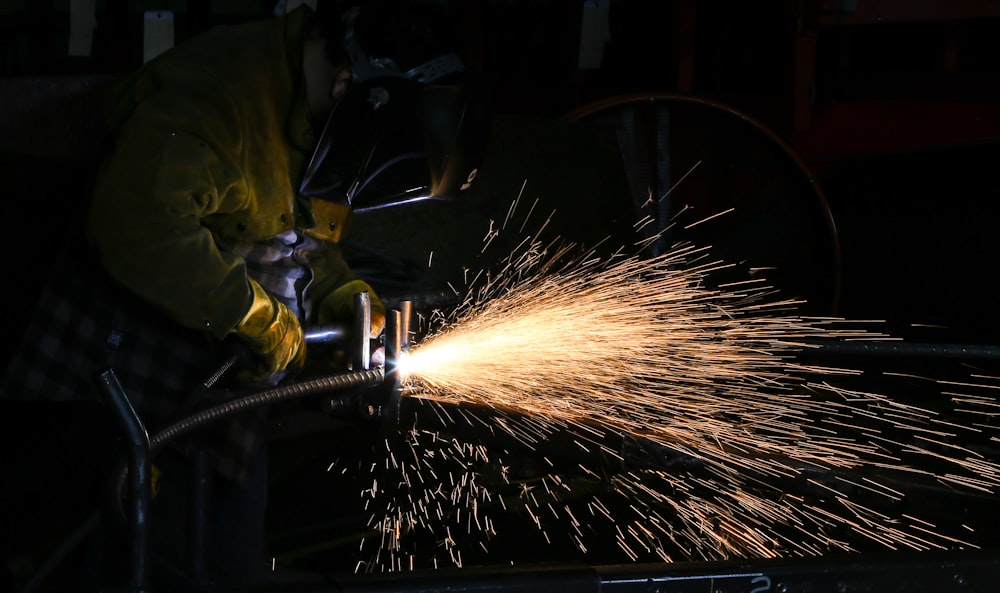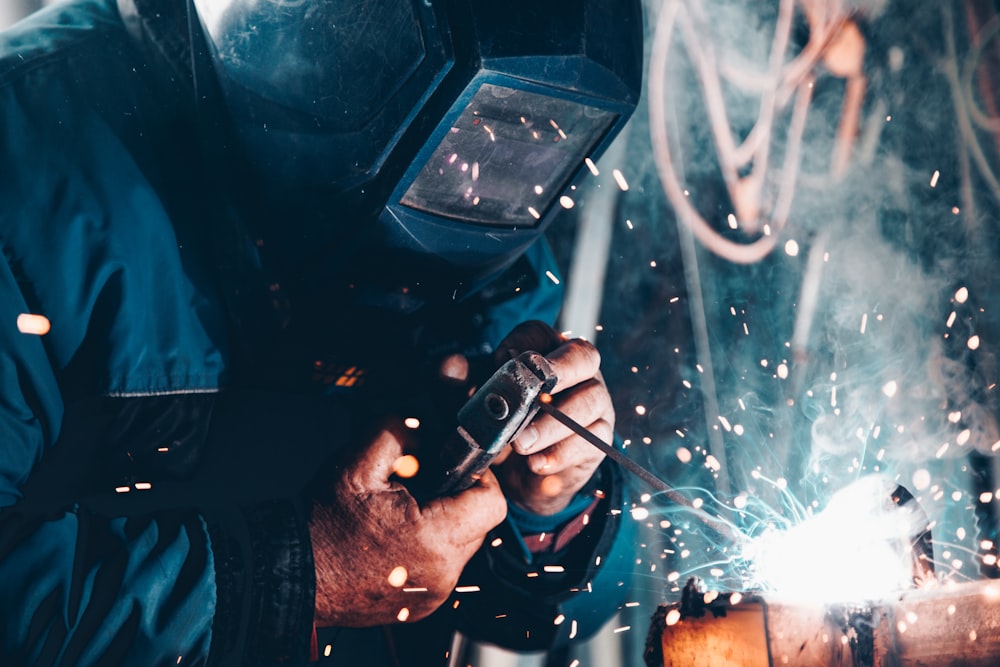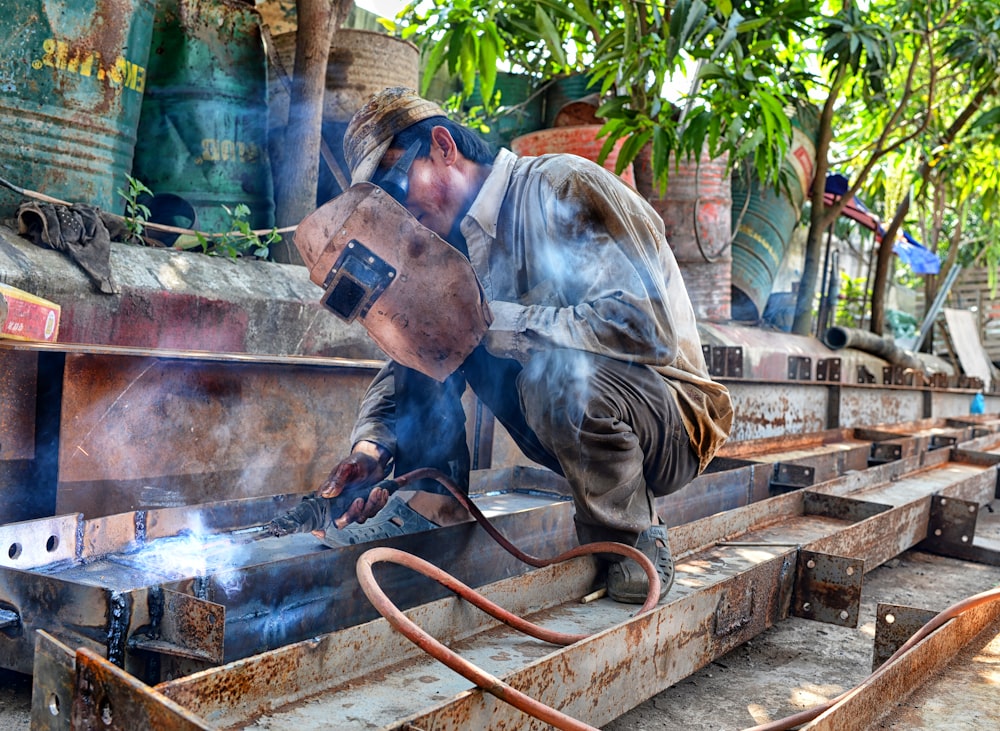Welding technologies are typically distinguished into solid and fusion welding. Both plasma welding and laser welding are forms of fusion welding.
Before diving into what each type of welding is, let’s look at some other types of welding.
Types of Welding
Depending on the metal you are using and the function it is supposed to perform, you can choose from several types of welding. Some will do a weak job, while some will be too solid.
Welding is categorized into different types depending on many factors, such as heating method, heat source, and kind of electrode. Some of the most common types are discussed below.
1) Gas Welding
In this type of welding, gas is used to produce heat or flame. Gas welding is preferable because the heat temperature can be controlled easily by changing the amount of gas.

2) Solid State Welding
As the name suggests, the welding process happens while the metal is still in its solid state. This means the metals are welded at temperatures less than their melting point.
3) Resistance Spot Welding
Electricity is passed through the objects to create heat that would be used to weld metals together. The current running through the metal produces resistance which in turn makes heat.
4) Arc Welding
Arc welding is done with an electrode. It is named so because of the arc that comes out of the electrode. This arc is used to generate heat.
5) Newer Welding
Heat can also be generated via friction. In this type of welding, metals moving at a fast speed collide. The resulting heat is used for welding.
Arc Plasma Welding (PAW)
The plasma arc welding process incorporates gas and arc welding advantages. Thus it is called fusion welding. The heat source is the plasma arc density beam. The gentle arc emits from a tungsten electrode.
Furthermore, the gas used throughout the process is argon gas, an inert gas. Other gases such as nitrogen, helium, or a mixture are also used.
Features of Arc Plasma Welding
- Higher welding speed – you’ll be done in minutes.
- Precision – you can use it for detailed and thin materials.
- It is highly porous and strong enough to penetrate 10-12 mm thick metal.
- Shape change – Objects will not be deformed during the welding process
- Outdoor Usage – you can use it indoors.
Application of Plasma Arc Welding
Plasma welding is frequently used in refractories and industrial processes. Due to its precision and penetrative strength, it is used in the production and manufacture of a wide variety of products.
Aircraft pieces and weaponry shells are made using this type of welding. Steel, copper, titanium, and their alloys are welded using PAW.
Basics of PAW
PAW is an arc welding process using non-consumable electrodes made out of tungsten. The main difference between both welding procedures was that in PAW, the electrodes are inserted into a nozzle, constricting an arc. Plasma gases are ionized inside the constricting nozzle and exit the nozzle quickly and effectively. It cannot be adequately protected with plasma gas by absorbing the gas and therefore supplies shielding gas around a plasma column like the GTAW process. The flow rate for the plasma gas is much lower than the shielding gas to minimize friction.
Plasma Arc Welding Process
Now let’s see how the welding process is carried out in PAW
When the gas passes through a heated arc, it expands. Then it is passed through a water-cooled nozzle. This compresses the gas. The continuous dissociation and compression create a plasma arc.
Advantages of Plasma Arc Welding
- Plasma welding costs much less than other types, considering the high-energy density tools needed.
- The plasma arc is constricted. However, the wider diameter of the column makes up for it. It is easier to join gaps and correct alignments using plasma welding.
- It is also easier to insert a filler metal with plasma welding.
- You can have arc consistency in plasma welding even at a low welding current output. You do not have to use a gas tungsten arc.
- Plasma arc welding uses a lesser welding current output. This allows for accurate and detailed welding applications.
- However, a higher welding current provides a longer arc. This is especially helpful when inserting metal fillers while doing manual welding.
- With plasma welding, you can create deep welds. This can decrease the risks of angular distortion.
Disadvantages of Plasma Arc Welding
- Plasma welding uses up a lot of heat. This can result in heat-affected zones and more extensive welds. You will end up getting distorted output objects.
- Although the plasma welding process is comparatively inexpensive, the tools used are quite expensive. This is because they are designed intricately to weld thin materials.
- Water is consistently required to compress the gas. This results in a minor plasma arc.
- A smaller arc is not suitable for joining gaps. Traditional gas tungsten arc welding can do a better job.
Laser Beam Welding
A high energy density laser beam is emitted in Laser Electron Beam Welding. The beam is the heat source for the welding process.
Two types of beams can be used for this welding method: pulsed laser systems or continuous laser systems.
When lower power is used, it is called heat conduction welding. In laser bottomless welding power supply is so high that you can drill holes into metal.
Features of Laser Beam Welding
- It is also a form of fusion welding.
- Reflective material can project the electron beam at the exact position.
- Pulsed laser beam welding does not require arm power. Inert gas is needed in continuous supply; otherwise, the metal will react with the air.
- Laser beam welding is used in conjunction with other types of welding, mainly MIG. This is an ideal solution when deeper penetration with a small power input is required, producing more comprehensive weld joints.
Application of Laser Beam Welding
Laser welding is a modern invention that has been adopted by manufacturers in various industries. It is used in the production of ships, cars, household appliances, smartphones, aircraft, and many other applications.
The array of its applications and success can be attributed to its swift precision and high welding speed.
Laser Beam Welding Process

The process is similar to that of electron beam welding. When the laser is projected at high power, the metal melts and evaporates, leaving holes behind. The hole is filled with heat and the steam of the evaporated metal.
Pressure is created inside the hole, which makes the molten metal flow in the hole. When the liquid metal solidifies, a weld is formed.
It can be carried out indoors as well. The laser welding systems are not bulky or complicated to operate.
Advantages of Laser Beam Welding
With the ever-evolving technology of laser beams, there are many benefits to choosing this welding method over others.
Laser beams are projected at the point of welding only. This is because they have high power density resulting in a concentrated heat source. In traditional welding methods, the heat applied reaches the surrounding area making it a heat-affected zone.
This causes distortion and bending in the material. However, laser beam welding has close to zero negative impact on the material.
Due to the distortion caused by the welding, it becomes necessary to grind or sand the material after the welding. Laser beam welding, on this point, leaves a clean weld that does not require additional treatments for a better look. It also saves on cost.
Lasers are no doubt faster than all other welding types. This means higher productivity and greater profits for the manufacturers.
Laser welding has unlimited applications. It is used by automobile and other transportation manufacturers, jewelry makers, pharmaceutical industries, smartphone manufacturers, and many more.

Disadvantages of Laser Beam Welding
Compared to other types of welding, the laser has only a few disadvantages. Since laser technology is so advanced, it costs much more than older technologies.
However, considering its productivity and efficiency, the investment might be worthwhile for you. A laser beam is exact and localized.
For example, this can cause problems if the workpiece is incorrectly set. When using laser welding systems, ensure you follow all the quality standards.
Similarities between Plasma Arc Welding and Laser Beam Welding
Both plasma welding and laser welding are types of fusion welding. In both welding methods, the filler material is inserted into the arc. Arc is located in the middle of the electrode and metal to be welded. In some welding types, the filler material itself is the arc.
Both processes cannot be carried out without the assistance of a welding machine. And both welding methods can provide deep welds and penetrations.
Differences between Plasma Arc Welding and Laser Beam Welding

To weld an area, a high-intensity laser beam is projected onto the localized point only. The beam generates heat. In PAW, a high-density plasma arc beam creates heat. Heat is what results in molten metals. The molten metals fill the gap or create a joining between two materials.
If you require a fusion weld, laser technology can be used in collaboration with MIG welding. There is no need to use plasma welding with other types of welding. It can weld deep into the metal at a lower power input.
A constant supply of inert tungsten gas is necessary. In case of the unavailability of tungsten, other gas can also be used. In the PAW, inert gas creates a shielding gas envelope around the weld pool.
It can be used indoors as well. No significant precautions or a laboratory environment are mandatory. However, PAW must be carried out in an environment that meets safety standards.
How are PAW and LBW Different From Traditional Welding?
In other welding methods, such as solid-state welding, no melting occurs. In both processes, however, the metal melts and forms a filler metal. In both PAW and LBW, heat is the source of energy. In some welding methods, pressure is applied to join materials.
The properties of the metals change drastically after welding due to heat. In other types where heat is not applied, there are a few minor changes only. Again due to the heat application, the material may lose its form. In solid-state welding, however, there is no deformation.
There are some similarities in these welding styles as well. All welding processes will result in a permanent weld. In all methods, a weld bead creates a permanent joint.
Conclusion
There is no single type of welding that is better than any other. People also use microplasma welding systems. Depending on the application, all kinds of welding can provide you with a strong weld, even if it’s welding carbon steel.
However, laser beam technology has taken the industries by surprise. With its unlimited applications and swift precision, it is undoubtedly the most competitive welding technology ever.
Which is better-paw welding or laser welding
Laser welding and paw welding are both forms of fusion welding. Each has its own pros and cons. Paw welding has higher accuracy, speed, and enough penetration strength for fire-resistant materials and industry use. Laser welding can be used with other types of welding, using less power to achieve deeper penetration and producing more complete welts. It is used in the manufacturing of household appliances and smartphones.
If you are unsure which product to choose, click the button below right now and our experts will provide you with the most professional advice!






